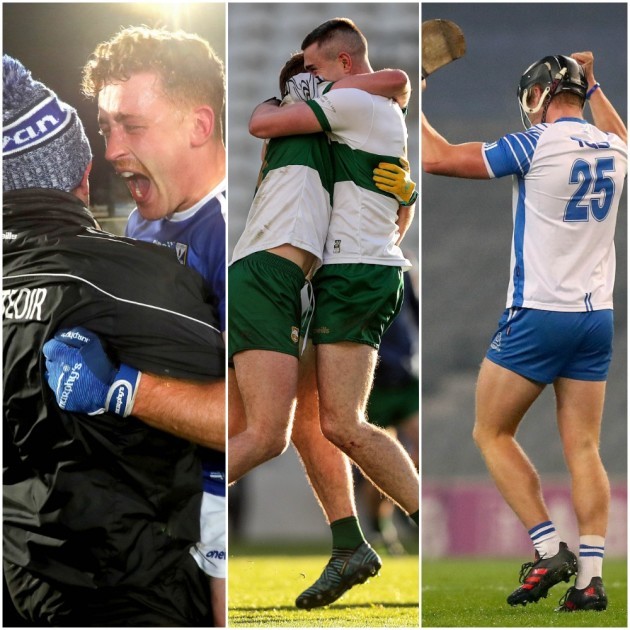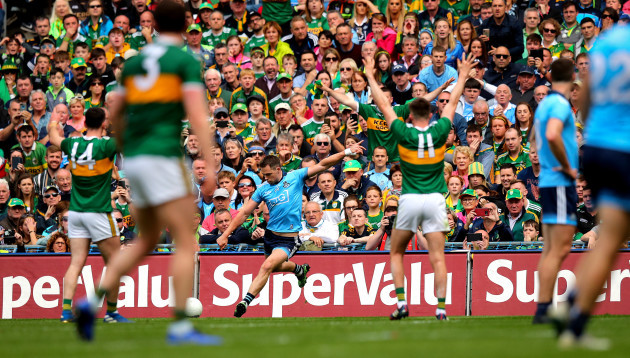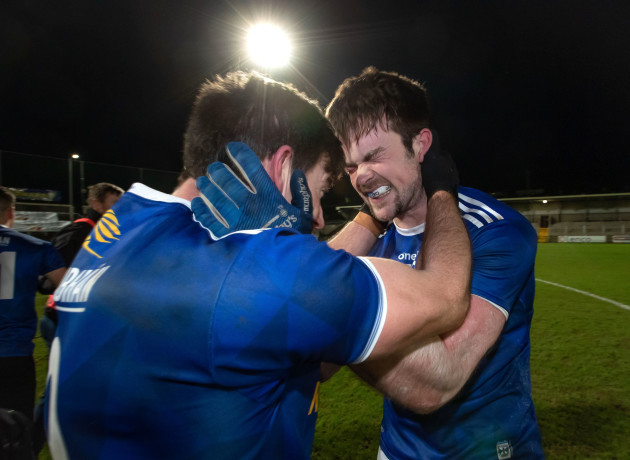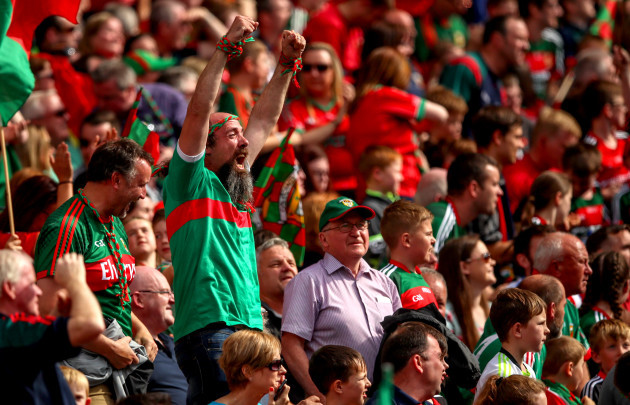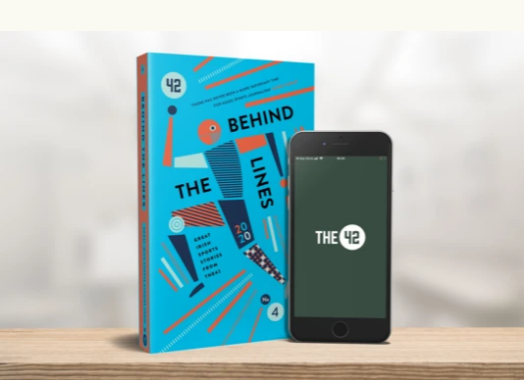IT’S HARD NOT to imagine the outpouring of raw emotion that would have engulfed the Athletic Grounds or Pairc Ui Chaoimh had supporters been allowed attend the unlikely provincial final wins of Cavan and Tipperary.
In years to come we’ll look back on photographs from the 2020 All-Ireland championships with a certain fascination. There’s a strange sort of beauty in the image of Colin O’Riordan on his knees, celebrating wildly with only stewards in the stand behind him.
The lack of crowd and atmosphere made it look like a game of no real importance was taking place. Watching the victorious players joyfully jumping around and hugging one another suggested otherwise.
It would have been lovely to have their own supporters to celebrate with inside the grounds at the final whistle, but would the underdogs have won the Munster and Ulster finals if they weren’t played behind closed doors?
It must have helped them settle into the games quicker, without mental space being taken up by all the outside distractions that come with a day of such importance.
Or at the very least, did the lack of crowds and the fact players are interacting less in the community help Tipp and Cavan handle the big occasion?
Imagine if Croke Park had been packed to the rafters last Saturday when Waterford hit wide after wide in the first-half against Kilkenny. A county support desperate for a first All-Ireland title since 1959 would have quickly grown frustrated. The groans after each wide would have only served to increase the pressure on players, further emphasising their poor start.
So in the year that Tipperary won their first Munster football title in 85 years, Cavan were crowned kings of Ulster for the first time since 1997, Cork dumped out Kerry, and Waterford put 2-16 from play past Kilkenny in the second-half to reach the All-Ireland hurling final, it’s worth considering the impact Covid is having on all of this.
Kate Kirby, head of performance psychology for the Sport Ireland Institute, made an interesting observation on Twitter last weekend.
I am increasingly believing that Covid might be playing into the hands of counties with less experience of big occasions. Lack of crowds, muted buildup with pubs closed & players working from home so interacting less in the community. Hype and tension lessened; focus increased?
— Kate Kirby (@sportpsychkate) November 28, 2020
“I am increasingly believing that Covid might be playing into the hands of counties with less experience of big occasions,” she wrote. “Lack of crowds, muted buildup with pubs closed & players working from home so interacting less in the community. Hype and tension lessened; focus increased?”
Inter-county squads have been told to reduce their social bubbles to help avoid positive cases which could jepordise the team’s season. It’s high-stakes stuff, so it’s probably safe to say county players are out and about in the community even less than the general public.
At Limerick’s All-Ireland final press night, Declan Hannon admitted he’s not talking about the game with supporters because “you’re not going anywhere or meeting anybody.”
The same is true for all squads and perhaps it’s the less experienced teams that it all affects more.
Going into more detail now, Kirby says: “I think it’s probably a combination of factors with the absence of crowds being one that could be contributing [to less experienced teams pulling off shocks].
“I’d also say the lack of interaction in the day-to-day lives of players and management could be to the advantage of counties where, if they’re rarely in the position of being in an All-Ireland semi-final or final, that the hype is absolutely massive in those counties where it happens less often.
“And the players being able to insulate themselves from that in the weeks leading up to it I think is the first thing that’s important to note.
“Historically any time I’ve worked with GAA teams, a lot of the work we would have done is how to cope with those casual interactions you have with fans and not to get too involved in discussions around tactics, who they’re marking or selection. So a lot of that is bypassed in their preparation this year.”
Then comes matchday itself which brings another wide range of distractions, particularly the bigger the occasion. It probably took Jack McCaffrey a few All-Ireland finals to learn that smiling in the pre-match parade and looking into the crowd helped him relax and focus.
“There’s kind of an agreement in sport that a lot of people don’t get it right the first time around in a final,” notes Kirby.
“There are things about playing regular provincial or league matches that are just different about a final. The more chances you have to practice being in a final the more times you get it right.
“So the counties that are there year after year in All-Ireland semi-finals and finals are not put off by the crowds because they’ve been there so many times. Whereas the counties that are less often even in provincial finals don’t get the opportunity to rehearse what the noise will be like of the crowds and the difficulty in hearing your team-mates instructions, the management’s directions from the sideline.
“The counties that have less experience of the big day can’t anticipate what that will be like until they’re there and they don’t get there very often. The bigger counties know exactly what that’s like, they’re there year-in year-out and so it doesn’t come as a shock to them.
“So for me that would be one of the biggest things, that they don’t need to anticipate how different All-Ireland day will be because it’s actually not that different.”
Another reason for the upsets could be that referees may no longer be inclined to give decisions in favour of the bigger or better supported teams according to Kirby.
“There’s also a suggestion that referees are also subconsciously biased to award frees in favour of the favourites,” she states.
It is backed up by research in professional soccer and basketball. “It’s not that they’re showing favouritism or they want a certain outcome or are trying to work in favour of a team.
“But that there’s such negative reaction with awarding frees against a home team and especially the big name players on the home team that the referees maybe are trying to avoid that negative response so tend to be more conservative in awarding frees against the favourites.
“So that could be another factor in why the underdogs are maybe coming to the fore this year, is that the subconscious influence of the crowd on the referee’s decision making has been removed.”
You’ll rarely hear a player admit in public that playing in front of a big crowd affects them in a negative way. The majority of county players have made it to this level because of how they handle the pressure that comes with playing in front of a crowd.
But some, especially those with less experience on the big stage, are undoubtedly impacted by it.
Many, like Mayo defender Stephen Coen, say they forget about the packed stands when the ball is thrown-in.
“I think I’ve learned over the years that favourites and underdogs really are irrelevant especially when it comes to championship, especially in the current structure,” says Coen.
“It doesn’t really matter who are the favourites and the underdogs; it’s just really about trying to get the most out of yourselves and trying to focus on your own performance as a group.
“If there is no crowd or not, once the game starts you’re only focusing on the game anyway. In terms of favourites and crowds, it doesn’t really matter to us.”
Cavan star Thomas Galligan is unsure whether the lack of supporters helped his team focus on the task in the Donegal game.
“Maybe,” he says. “I don’t know to be honest. I think everyone wants fans to be there.
“The Cavan supporters are passionate. If they were there you’d give you that extra step, make you make that extra run or put in that tackle.”
Having fans roaring encouragement will surely have a positive impact, but what if it’s the other way around? Even tension in the crowd can make its way onto the field.
When Andy Moran’s second-half goal drew Mayo level in the 2013 All-Ireland final, they looked ready to push for home. Instead of being excited at the prospect of the famine finally ending, the Mayo supporters were filled with fear at the thought of another heartbreaking near-miss.
That’s what talk of a ‘curse’ over generations can do to a collective mindset. On the sideline that day was James Horan, who later recalled the anxiety rolling off the terraces and infecting the players.
“Would it have changed things that day? I dunno, but there was a sense of anxiety, that day, that came as opposed to taking the moment,” he said. “I felt that a little bit, yeah. There was a sense of anxiety, that day, that came as opposed to taking the moment.”
Kirby explains the psychology behind this.
“I know ‘home advantage’ is a very well known phenomenon, but there is research around ‘home disadvantage’ as well on how the passion of the home crowd can actually sometimes work against the home team,” she says.
“Now obviously in GAA in provincial finals there isn’t such a disparity in crowd numbers for each team. But players would usually say they don’t pay attention to the crowds but again, it’s subconsciously you’re taking in the atmosphere. You will be aware if there is a positive or negative reinforcement for your actions.
“I think it probably generates stronger momentum positive or negative when the crowd is there.”
Reflecting on the lack of crowds at Mayo’s recent press night, Horan observed: “There probably isn’t as much emotion swirling around the place. Not that you get caught up in it but crazy stuff happens when there are so many people around the place and people around dressing rooms and all that kind of stuff.
“And sometimes that can add to the anxiety a little bit. So I think it’s a more consistent performance area, if you want to put it that way, when there isn’t crowds.”
The hype in Waterford went into overdrive for their last All-Ireland final appearance in 2017, when they lost narrowly to Galway. With players now effectively locked away from the general public, they should benefit from the low-key build-up to the game.
But how exactly would a simple conversation with a supporter negatively impact on a player’s mindset heading into a game?
“A lot of what you’d try to do when you’re analysing opposition or even your own task of performance is extract what’s fact and what’s opinion,” explains Kirby. “Then you plan around what’s fact and try discard opinion because it’s completely subjective and bias.
“So when you’re in the bubble of the team what you’d try stick to are facts. Like, ‘this team have tall midfielders or have a very good percentage on their kick-outs’ and then you plan your tactics around countering those factual strengths of the opposition.
“The casual interactions you have in the street are generally very subjective and opinions. They’d say, ‘That fella is very quick under a high ball’ or ‘they have a lightning quick centre-forward’, when in fact they don’t have any data to back-up that opinion.
“It’s usually based on a narrow exposure to watching a player for a short period of time or a match they might have happened to catch earlier in the season.
“So you start to get confused between what’s evidence based and what’s subjective opinion,” she continues.
“So it increases hugely the amount of information the players are taking in and then it must be a mental load for them to try and remember what’s actual facts and what’s opinion that they need to discard.
“It also subconsciously can change your perception of the opposition or the person you’re marking. You might hear on the street that ‘that girl is very technically good’ and you can’t just unhear that after you’ve heard it.
“Even though you might decide you’re not going to take it seriously, it’s still gone in there and we’re not fortunate enough to be able to just erase our memory selectively. So all of those little throwaway comments that you’re at the receiving end of as a player are in your mind. Whether you believe them or not, they’re still in there.”
While Dublin are used to playing in front of a packed Croke Park their process-driven approach and familiarity with the venue means the empty stadium is unlikely to have affected them much.
Perhaps it has even benefited Dessie Farrell’s side because their on-field communication is so good.
“Athletes will say they don’t pay much attention to the crowds, but subconsciously do they get energy from them when they’re tired? I would say it’s probably very likely.
“But a lot of these athletes are very self-motivated and task focused so the presence or absence of a crowd shouldn’t really influence their level of effort or energy expenditure you’d think.
“Dublin are so experienced and have shown such an ability to perform, I don’t know if it’s going to have as big an influence in that respect. I think most teams and players at that level have a huge degree of focus on execution of the task which should be completely separate from the presence or absence of a crowd.”
It may also help the standard of play in big games as players can hear shouts from one another that would have typically been drowned out by the heaving support.
“I know from years gone by when you’re playing in a game with 80,000 people and you’re expected to get a message from someone behind you on the field, you literally have to keep your head on a swivel because you can’t hear them at all so you need to be aware of what’s around you,” says Coen.
“Whereas now it allows you look forward more often because people behind you can give you a clear message, clear on kick-outs, positioning and stuff like that.
“Even from the crowd, you can hear selectors and subs on the side giving you clear messages of something that’s over your shoulder that you mightn’t see. From that point of view in terms of effective communication it definitely helps and is a lot easier.”
